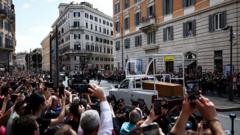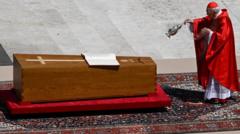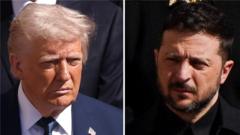As cardinals gather to discuss the future direction of the Church, they balance tradition with the urgency of electing a new leader.
Papal Transition: Cardinals Gear Up for a New Chapter

Papal Transition: Cardinals Gear Up for a New Chapter
With Pope Francis's passing, cardinals prepare for critical meetings to elect the next leader of the Catholic Church amidst a no-campaign sentiment.
In March 2013, Cardinal Jorge Mario Bergoglio of Argentina famously presented a visionary speech during closed meetings before his election as Pope Francis. Now, following his recent passing, cardinals will enter a pivotal week of discussions, gauging the priorities and personalities of potential successors, who are termed papabili, or pope material.
The preceding days saw masses of the faithful present at Francis’ funeral, marking not just the loss of a beloved leader but gearing up for a monumental transition as cardinals assemble for crucial dialogues. Starting Monday, these general congregations will intensify, functioning almost like a clandestine campaign leading to the upcoming conclave scheduled for next month.
In a gentle yet strategic ambiance, cardinals under 80 years old — the voting body — will engage in initial statements addressing pertinent issues within the Church. These meetings not only serve to reveal character and charisma but also to potentially highlight candidates’ weaknesses, as the unwritten rule during this non-campaign campaign forbids overt self-promotion.
Vatican tradition dictates that the public should not witness active campaign tactics; instead, an atmosphere of subtlety prevails. History shows how a candidate can transition from obscurity to papacy based on the impressions made during this phase — a precedent set famously by Cardinal Joseph Ratzinger, who after a stirring homily for Pope John Paul II, ascended to become Pope Benedict XVI shortly thereafter.
The stage is set for another pivotal moment in the Catholic Church’s history as cardinals collectively navigate the delicate balance of reverence, strategy, and tradition leading into the conclave where a new direction for the Church awaits.
The preceding days saw masses of the faithful present at Francis’ funeral, marking not just the loss of a beloved leader but gearing up for a monumental transition as cardinals assemble for crucial dialogues. Starting Monday, these general congregations will intensify, functioning almost like a clandestine campaign leading to the upcoming conclave scheduled for next month.
In a gentle yet strategic ambiance, cardinals under 80 years old — the voting body — will engage in initial statements addressing pertinent issues within the Church. These meetings not only serve to reveal character and charisma but also to potentially highlight candidates’ weaknesses, as the unwritten rule during this non-campaign campaign forbids overt self-promotion.
Vatican tradition dictates that the public should not witness active campaign tactics; instead, an atmosphere of subtlety prevails. History shows how a candidate can transition from obscurity to papacy based on the impressions made during this phase — a precedent set famously by Cardinal Joseph Ratzinger, who after a stirring homily for Pope John Paul II, ascended to become Pope Benedict XVI shortly thereafter.
The stage is set for another pivotal moment in the Catholic Church’s history as cardinals collectively navigate the delicate balance of reverence, strategy, and tradition leading into the conclave where a new direction for the Church awaits.




















